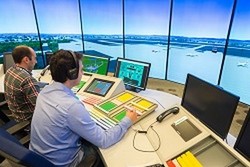Predictive data opens new era in traffic control
Increased traffic in the skies and at sea requires ever more precise and predictive management to guarantee safety, achieve efficiencies and avoid gridlock. Advanced tracking systems capable of managing and exploiting historical data on moving objects can give authorities predictive powers to prevent accidents and delays and ensure that global transport functions smoothly. “Accurate forecasts of trajectories and events are important for safety, cost, credibility and environmental-friendliness,” explains datACRON (Big Data Analytics for Time Critical Mobility Forecasting) project coordinator Professor George Vouros from the University of Piraeus Research Centre in Greece. “For instance, preventing ship accidents through better monitoring of vessel activity represents a substantial saving for shipping companies, and protects marine ecosystems.” The goal of the EU-funded datACRON project has therefore been to develop technology capable of detecting and forecasting moving objects’ trajectories, recognising and predicting important events before they happen and then processing and relaying all this data visually to operators. Smooth operations Once up and running, the new system will increase situational awareness in the maritime domain and deliver new predictive tools for air traffic managers and controllers. “This might mean for example being able to identify imbalances between demand and capacity of resources (e.g. airspace sectors), and the extent to which aircraft will have to deviate from original flight plans,” says Prof. Vouros. “In the maritime domain, continuous, timely tracking of fishing vessels and surrounding traffic can ensure security and limit illegal fishing activities.” In the online layer of the system, streaming surveillance data describes the positions of moving entities. These are then fed into the system, where several online operations are performed, aiming to put online low-level event detection, trajectory reconstruction and compression: This is important given that the goal is to only keep high-quality data that is of importance to trajectory analytics and complex event forecasting components. The system transforms data from any source into usable information. This means that relevant data originating from other sources are integrated, resulting in information-rich trajectories. Further analysis of these enriched trajectories enables predictions of future locations of moving objects, as well as complex event forecasting. Offline components are used to analyse trajectories and discover hidden patterns. Visualising the challenge In developing the system, the project consortium had to find ways of managing data from a wide variety of diverse sources. “This presented a number of challenges, such as scalability of processing, integration and efficient management of data,” says Prof. Vouros. “Predicting trajectories and detecting/forecasting events involves the online reconstruction of an object’s entire trajectory, supported by online processing and analysis of streams of data. Algorithms to predict anticipated trajectories at different time scales, and algorithms for complex event recognition and forecasting online are further challenges addressed.” The next challenge facing the team was to make this data fully accessible and complementary to human expertise. “In this respect, visual analytics has created opportunities for human analysts and computers to really work together,” says Prof. Vouros. “We developed appropriate visual tools that facilitate the inclusion of the human domain expert’s tacit knowledge and his capabilities for reasoning and intuition into the decision process.” Due for completion at the end of 2018, the technology pioneered by Prof. Vouros and his colleagues is currently being evaluated and validated in both air traffic control and maritime monitoring situations. Feedback from these exercises will be incorporated during the final stages of the project. “This is exactly where we are now, though further refinements are constantly being introduced at all levels of the system,” he says.
Keywords
DATACRON, air traffic, maritime, marine, monitoring, analytics, data, shipping







